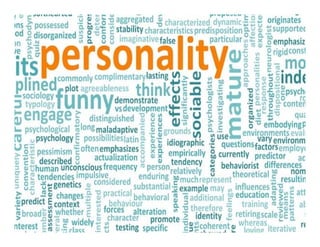Era psychometrictests
- 3. • Began in late C19th with “intelligence” testing • Francis Galton, UK: Anthropometrics–taking a mathematical approach to the measure of individual differences –eugenics • Charles Spearman, USA 1910 –contributed ‘g’ or the measurement of general intelligence factor Brief history of psychometrics
- 4. And “factor analysis”–the means by which psychometric tests are found to be valid • 1917 Stanford‐Binettest: first standardised test of intelligence • 1949: First publication of the 16PF by Raymond Cattell(Spearman’s student) Brief history of psychometrics (Cont’d)
- 5. • 1962: MBTI first published –type‐based instrument; four preference scales • 1963 First appearance of the “Big Five "of personality factors (OCEAN) • 1970: Cronbach(Cronbach’sAlpha): emphasizes the importance of validity –being able to predict accurately what a person will do Brief history of psychometrics (Cont’d)
- 6. • 1984: OPQ32 introduced, published by SHL R&D by Peter Saville and Roger Holdsworth • 1986: Hogan’s Personality Inventory first published • 2004 Savilleand Holdsworthousted from SHL’s board • 2007 Saville’s Personality Questionnaire / Wave introduced Brief history of psychometrics (Cont’d)
- 7. What is a psychometric test? • Aim to measure aspects of your mental ability, aptitude or your personality • Used as part of the recruitment or selection process • Provide employers with a method of selecting the most suitable job applicants or candidates for promotion • Used by 80% of Fortune 500 and 75% of Times Top 100 companies
- 8. What do psychometric tests measure? • How well you work with other people • How well you handle stress • Whether you will be able to cope with the intellectual demands of the job • Your personality, preferences and abilities • Most do not analyze your emotional or psychological stability • Best match of individual to occupation and working environment
- 15. Some of the popular psychometric tests are: • The Five Factors Model • 16 PF • MBTI • OPQ32 • Hogan • Saville • Thomas Personal Profiling System • Colors Personality • Strength Finder • Gordon’s Personal Profile Inventory • Rorschach Ink‐Blot Test • FIRO‐B • Picture Frustration Test • Thematic Apperception Tests (TAT)
- 16. The Five Factors Model Basis of many tests: Uses five personality traits: • Openness • Conscientiousness • Extraversion • Agreeableness • Neuroticism
- 18. FIRO‐B: • Devised by American psychologist, Will Schutz, in the 1950's • Helps people to understand themselves and their relationships with others • Based on a 2‐hour, 54‐question questionnaire • Describes interpersonal behavior in terms of three primary dimensions: – 1. Need for Inclusion – 2. Need for Control – 3. Need for Affection FUNDAMENTAL INTERPERSONAL RELATIONSHIP ORIENTATION‐BEHAVIOUR
- 20. MBTI: Myers‐Briggs Type Indicator • Based on theories of Gustav Jung • Most widely‐used questionnaire based test • Uses four bi‐polar dimensions – Sensing –Intuition (SN) – Thinking – Feeling (TF) – Extraversion‐Introversion (E‐I) – Judging‐Perceiving (J‐P) • To create 16 ‘Personality Types’
- 22. The DISC Personality Model • Developed in 1920s to understand ‘why people do what they do’ • Simple questionnaire based • Uses four categories of human behavioral styles – "D" for Dominance‐Drive‐Direct, – "I" for Influence – "S" for Steadiness or Stability – "C" for Compliant, Conscientious, or Cautious Direct, Influencing, Steady and Compliant behaviors.
- 25. 16 Personality Factor model (16PF) • Developed in the 1940s and refined in the 60s • Attempts to define the basic underlying personality • Questionnaire based • Analysis using 16 personality factors
- 26. Factor Descriptors A Warmth Reserved Outgoing B Reasoning Less Intelligent More Intelligent C Emotional Stability Affected by feelings Emotionally stable E Dominance Humble Assertive F Liveliness Sober Happy-go-lucky G Rule Consciousness Expedient Conscientious H Social Boldness Shy Venturesome I Sensitivity Tough-minded Tender-minded L Vigilance Trusting Suspicious M Abstractedness Practical Imaginative N Privateness Straightforward Shrewd O Apprehension Self-Assured Apprehensive Q1 Openness to Change Conservative Experimenting Q2 Self-Reliance Group-dependent Self-sufficient Q3 Perfectionism Self-conflict Self-control Q4 Tension Relaxed Tense The 16 factors with their word descriptors of each scale
- 28. BELBIN TEAM ROLE INVENTORY • Used to place individuals in their most effective team roles • Categorises team roles under three orientations: – Action‐oriented roles – People‐oriented roles – Cerebral roles
- 30. Belbin team profiling is used to: • Create balanced working teams: – One Co‐coordinator or Shaper (not both) for leader – A Plant to stimulate ideas – A Monitor/Evaluator to maintain honesty and clarity – One or more Implementer, Team worker, Resource investigator or Completer/finisher to make things happen
- 32. SHL OPQ 32 Questioner • The authors were Saville et al., including Roger Holdsworth, Gill Nyfield, Lisa Cramp and Bill Mabey, and they were launched by Saville and Holdsworth Ltd. in 1984. • The series included the first commercially available Big Five instrument. • The OPQ measures 32 different personality traits that are relevant to occupational settings.
- 35. Wave Professional Styles • In 2007, Saville and colleagues carried out Wave questionnaire • In 2014, Salgado and Tauriz found that Saville Consulting Wave is in the category of questionnaires whose scoring design provides the most valid way to predict job performance. • The research indicates that rather than either a solely normative (rating) or ipsative (ranking) approach, questionnaires which steer a middle course between the two approaches provide a method with greater validity
- 38. Aptitude and Ability Tests • Designed to assess one’s logical reasoning or thinking performance • Usually consist of multiple choice questions, administered under exam conditions • Typical test might allow 30 minutes for 30 or so questions • At least 5000 aptitude and ability tests on the market • On‐line testing increasingly popular
- 40. For more information: BOOKS Anastasi Anne, Urbina Susana, Psychological Testing, Pearson Education, 2003. Mcshane S, Glinow A M, Sharma R, Introduction to Organization Behavior, Tata McGraw Hills, 2006. E‐Books D.Constantine‐Simms, Everything you need to know to pass psychometric tests. Magazines HRM Review February 2007 Websites http://www.teamfocus.co.uk/different_types_of_psychometric_tests.htm http://changingminds.org/disciplines/hr/selection/psychometric.htm http://www.personalitypathways.com/type_inventory.html http://en.wikipedia.org www.humanmetrics.com http://www.opp.co.uk
